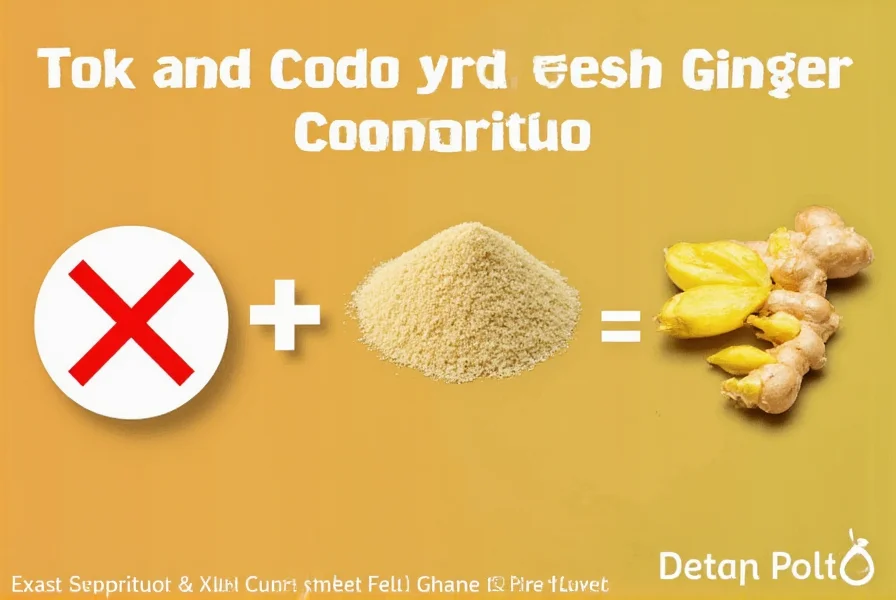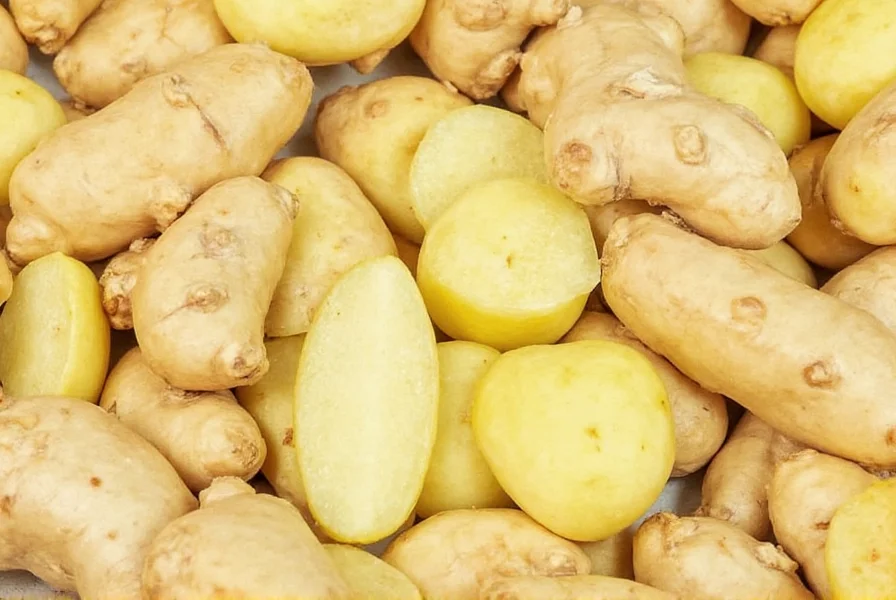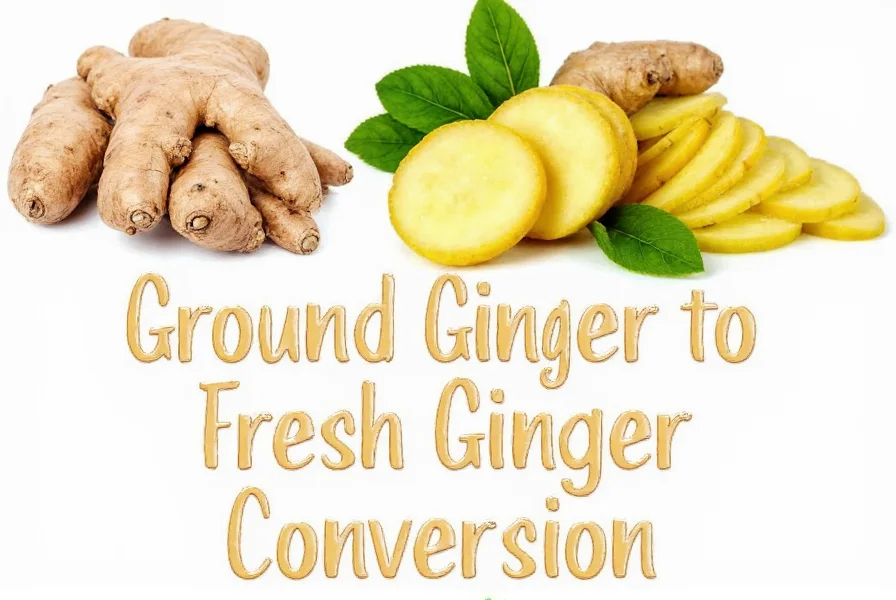The standard conversion is 1/4 teaspoon of ground ginger equals 1 tablespoon of fresh ginger. This ratio accounts for the concentration difference between dried and fresh forms, as ground ginger has more intense flavor due to moisture removal during processing.
Understanding ginger substitutions is essential for home cooks who frequently encounter recipes calling for one form when they only have the other available. While both ground and fresh ginger originate from the same rhizome, their flavor profiles and potency differ significantly due to processing methods. This guide provides precise conversion measurements, explains when substitutions work best, and helps you maintain recipe integrity regardless of which form you have on hand.
Why Ground and Fresh Ginger Aren't Directly Comparable
Ground ginger undergoes a drying and grinding process that concentrates its flavor compounds while removing moisture. Fresh ginger contains approximately 70% water, which dilutes its flavor intensity. When manufacturers produce ground ginger, they remove this moisture, resulting in a more potent product by volume. This concentration explains why you need significantly less ground ginger to achieve similar flavor impact.
Complete Ginger Conversion Reference
| Ground Ginger | Fresh Ginger Equivalent | Best Used For |
|---|---|---|
| 1/8 teaspoon | 1.5 teaspoons grated | Delicate sauces, beverages|
| 1/4 teaspoon | 1 tablespoon grated | Baking, marinades, general cooking|
| 1/2 teaspoon | 2 tablespoons grated | Stronger flavor profiles, hearty dishes|
| 1 teaspoon | 1/4 cup grated | Intense ginger recipes, preserves
Flavor Profile Differences You Should Know
Fresh ginger offers bright, citrusy notes with a sharper heat that dissipates relatively quickly. Ground ginger provides warmer, more earthy flavors with subtle camphorous notes and longer-lasting warmth. The drying process creates new flavor compounds through oxidation and enzymatic changes, resulting in distinct culinary characteristics.
Chefs specializing in Asian cuisine often emphasize that fresh ginger works best in savory dishes where its bright, pungent qualities shine, while ground ginger excels in baked goods and spice blends where its warmer notes complement other dried spices.

When Substitutions Work Best (and When They Don't)
Successful substitutions: Baking projects like gingerbread, cookies, and spice cakes typically accommodate ground ginger well. The extended cooking time allows its flavors to mellow and integrate properly with other ingredients.
Limited success: Stir-fries, curries, and fresh sauces benefit more from fresh ginger's vibrant bite. If substituting, add ground ginger early in cooking to mellow its intensity and consider adding a splash of citrus juice to mimic fresh ginger's brightness.
Avoid substitution: Garnishes, pickled ginger preparations, and recipes specifically highlighting fresh ginger's texture require the actual fresh product. The visual and textural elements are integral to these dishes.
Practical Tips for Effective Substitution
When converting recipes, remember that ground ginger's potency varies by brand and age. Older ground ginger loses volatile compounds, requiring slightly more for equivalent flavor. For critical recipes, perform a small test batch first.
For recipes calling for fresh ginger where you're using ground, add the ground ginger to liquid ingredients first to help distribute it evenly and prevent clumping. In baking applications, whisk ground ginger thoroughly with other dry ingredients before combining with wet components.
When substituting fresh for ground in baking, increase liquid content by 1-2 teaspoons per tablespoon of fresh ginger to compensate for the additional moisture. This prevents your baked goods from becoming too dry.

Storage Considerations Affecting Potency
Ground ginger maintains peak potency for 2-3 years when stored in an airtight container away from light and heat. Fresh ginger lasts 2-3 weeks refrigerated in a paper bag, or up to 6 months frozen. As both forms age, their flavor intensity decreases, requiring slight adjustments in substitution ratios.
Test older ground ginger by rubbing a small amount between your fingers and smelling it. If the aroma is faint, you'll need to use slightly more than the standard conversion ratio. For older fresh ginger with wrinkled skin, increase the amount by 25% to compensate for moisture loss.
Common Substitution Mistakes to Avoid
Many home cooks make the error of using equal measurements when substituting, resulting in overpowering or weak ginger flavor. Remember that 1 tablespoon of fresh ginger does not equal 1 tablespoon of ground ginger—the correct ratio is 1:3 by volume.
Another frequent mistake involves substituting in raw applications like smoothies or salad dressings. Ground ginger doesn't dissolve completely in cold preparations, creating an unpleasant gritty texture. In these cases, steep ground ginger in warm liquid first, then strain before using.
Special Considerations for International Cuisines
Different culinary traditions treat ginger substitutions uniquely. In Indian cooking, recipes often specify both fresh and dried ginger for layered flavor. Middle Eastern spice blends typically use only ground ginger, while Japanese and Chinese cuisines prefer fresh for most savory applications.
When adapting international recipes, research the specific cuisine's ginger usage conventions. Authentic Thai curry pastes, for example, require fresh ginger for proper flavor development, while Jamaican ginger cake traditionally uses ground for its distinctive warmth.
Can I use ground ginger instead of fresh in tea?
Yes, use 1/8 teaspoon ground ginger per cup of hot water. For better extraction, first mix the ground ginger with a small amount of cold water to form a paste before adding hot water. Fresh ginger typically provides brighter flavor in teas, but ground works well when fresh isn't available.
Why does my substitution make recipes taste different?
Ground and fresh ginger have different flavor compounds due to the drying process. Ground ginger develops warmer, more earthy notes while fresh offers brighter, sharper flavor. The conversion ratio gets you close, but the flavor profile will differ slightly. For closer approximation, add a squeeze of lemon juice when substituting ground for fresh.
How do I substitute fresh ginger for ground in baking?
Use 1 tablespoon freshly grated ginger for every 1/4 teaspoon of ground ginger called for. Increase liquid ingredients by 1-2 teaspoons per tablespoon of fresh ginger to compensate for added moisture. For best results, squeeze excess liquid from grated ginger before adding to dry ingredients.
Does the conversion ratio change for crystallized ginger?
Yes, crystallized ginger requires different conversion. Use 2 tablespoons chopped crystallized ginger for every 1/4 teaspoon ground ginger. Remember that crystallized ginger adds significant sweetness, so reduce other sweeteners in your recipe accordingly.
Can I make my own ground ginger from fresh?
Yes, peel and thinly slice fresh ginger, then dehydrate until completely brittle (about 8-12 hours at 135°F). Grind in a spice grinder to powder consistency. Note that homemade ground ginger will be more potent than commercial varieties since it contains no anti-caking agents. Use 20% less than standard conversion ratios.











 浙公网安备
33010002000092号
浙公网安备
33010002000092号 浙B2-20120091-4
浙B2-20120091-4